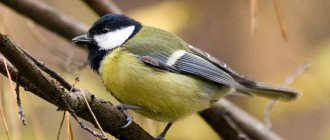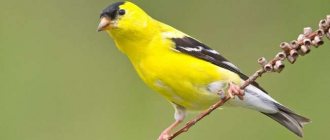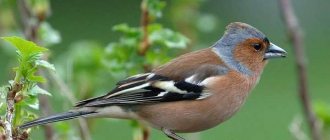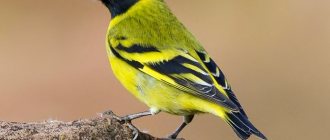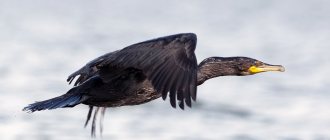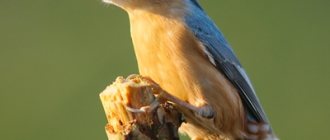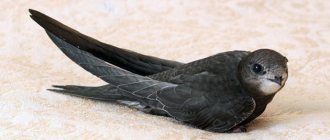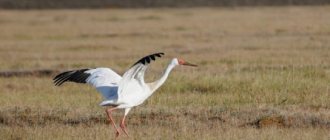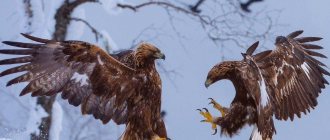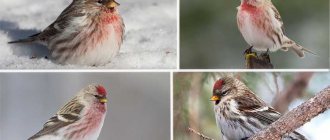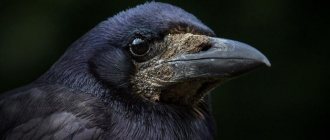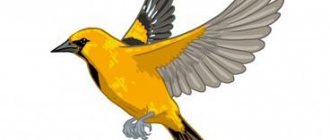Who doesn’t know that the nightingale sings the best bird on earth. A photo of a natural singer, as well as an audio recording of divine singing in our article.
The nightingale belongs to the thrush family of birds. Sexual dimorphism in these birds is not pronounced. The nightingale is a slender bird, slightly larger than a sparrow. The coloration is dominated by reddish-olive-gray tones, a little brighter on the chest, and the belly is ocher-variegated. The eyes are large, dark, like beads. The nightingale holds its tail straight, and when it sits on a branch, it alternately raises and lowers it.
Nightingale bird. Photo of a natural singer
Description of the bird
— Advertising —
This is what a nightingale looks like on earth
The most famous songbird in the CIS countries is the nightingale from the flycatcher family of the passeriformes order. Despite their wonderful voice, nightingales are not distinguished by their external beauty.
Appearance
In the photo: a nightingale sitting on a branch
A common representative of the species - the common nightingale weighs 25 g, body length in males and females - 16-17.5 cm, wingspan 24-27 cm. The plumage color of the common nightingale is olive-brown, the tail and wings are darker , and the abdomen is lighter, the sides are gray, the beak is small, yellow.
The nightingale looks quite ordinary, more like a sparrow than a bird with an outstanding voice.
How nightingales prepare for mating season
During the breeding season, birds usually return to the same nest year after year. The male performs mating rituals, sings soft songs for the female, flaps and flares his tail, and sometimes lowers his wings. Sometimes during the rutting period the male chases the female, at the same time uttering pitiful sounds “ha-ha-ha-ha”.
p, blockquote 23,0,0,0,0 —>
Then the groom lands next to his chosen one, sings and dances, lowers his head low, flares his tail and trembles his wings.
p, blockquote 24,0,0,0,0 —>
During the fertile period, the female receives food from the contender for the heart. The partner also “guards the bride,” following her wherever she goes, sitting on a branch directly above her and observing her surroundings. This behavior reduces the likelihood of competition with other males for a female.
p, blockquote 25,0,0,0,0 —>
What do they eat?
— Advertising —
This is what a nightingale looks like in flight
Nightingales feed on worms, earthen insects, spiders, and ant eggs. In summer and autumn, nightingales add berries to their diet. In captivity, bone meal, shells, feed yeast, hamarus, cottage cheese, chicken eggs, and sunflower seeds are used as substitutes for natural food for nightingales. Nightingales also eat walnuts, boiled meat and millet, fruits, berries and vegetables.
Where does he live?
This is what a nightingale looks like while singing.
The nightingale's distribution range is wide.
Birds are found in Europe, Western Asia and the Yenisei. Nightingales winter in Africa. For nesting, they prefer bushes or forest edges located near bodies of water, as well as groves, gardens and parks.
Pairing
Females fly to the territory of males in the evening and quietly wait until the morning. At dawn they begin to whistle softly to attract attention. Often at this moment they jump along the branches of a bush or on the ground. The male, in turn, begins to wriggle, taking different poses, lowers his wings, hunches over and opens his tail. This is how a couple is formed. The female takes off and the male follows her, making creaking sounds. So he chases his chosen one.
A few days later, when the female has become accustomed to the male’s nesting site, she finds a good place to build a nest.
Migratory bird or not
— Advertising —
This is what a nightingale looks like in flight
The nightingale is a migratory bird. Migration begins in mid-August and lasts until mid-October. The nightingale flies to southern countries for the winter. Winters in Africa, south of the equator, but not north of southern Ethiopia. Nightingales fly to their native lands in the spring from mid-April to early May.
How nightingales give birth and care for them
The breeding season varies by range, but most often occurs from late April to mid-July throughout Europe. This species usually produces two broods during the mating season.
p, blockquote 26,0,0,0,0 —>
The nightingale's nest is located 50 cm from ground level at the base of a hummock or low grass, well camouflaged by the parents among the fallen leaves. The shape of the nest is an open bowl (but sometimes with a dome), a bulky structure made of fallen leaves and grass. The inside is covered with small grasses, feathers and animal hair.
Kinds
Today, ornithologists track 14 species of nightingales, which differ in external characteristics, singing abilities and habitat. In this article we will talk about the most popular nightingales in the CIS according to search queries.
Common Nightingale
Common or eastern nightingale
- Latin name : Luscinia luscinia
- Weight : 24 g (large adult bird)
- Highest classification : Nightingales
- Conservation status : Least Concern
Common Nightingale (Eastern Nightingale) - This species has the largest population in the nightingale genus. The bird's plumage is warm brown with a characteristic gray-brown pattern of spots on the chest. In the wild, the lifespan of the common nightingale is 8-10 years, some nightingales live up to 12 years.
Western or southern nightingale
The size of this species reaches the size of a sparrow. The belly and chest of the birds are gray-yellow, the plumage of the back and wings is brown with an olive tint. There are no patterns on the chest, thanks to which the species can be distinguished from the common nightingale.
Rubythroat Nightingale
- Latin name : Luscinia calliope
- Weight : 20-30 g (large adult bird)
- Highest classification : Calliope
- Conservation status : Least Concern
The Ruby-throated Nightingale is a small bird with a light breast and an olive-brown back. A characteristic feature of the male of this species is the red plumage of the throat. These birds sing loudly, but their song is shorter than that of an ordinary nightingale.
Red-breasted Nightingale
- Latin name : Tarsiger hyperythrus
- Weight : 11-16 g (large adult bird)
- Body length : 12-13 cm
- Highest classification : Nightingales
- Conservation status : Least Concern
The male red-breasted nightingale is handsome with an orange belly and a blue tail and wings. The body length of this species is about 13 cm, weight – up to 16 g. This species is widespread in the Himalayas, India, China, Bhutan, and Myanmar.
Blue Nightingale
The blue nightingale is a small species (about 15 g) with a pronounced difference between females and males. Males have blue-black plumage on the back, brown wings, black beak and cheeks, breast and abdomen are pearl-gray. Female blue nightingales are similar to females of the common nightingale. Sometimes their color has a blue tint. But the song of blue nightingales sounds simpler.
Distribution area of nightingales
Formally, all species of these birds can be divided into migratory and sedentary. Nightingales are extremely common in nature. Many of their species are found in the summer throughout Eurasia, nesting even in the northernmost regions. Since temperatures there can drop dramatically in winter, these birds are forced to migrate to Africa. Some species are found only in Africa. Typically, birds that nest in southern Eurasia and Africa are sedentary. A significant population of these birds is found in India and southern China. They do not need to fly to regions with more favorable climatic conditions, since they, being modest in size, can easily feed themselves.
It is believed that nightingales do not have good mental abilities
These birds do not live in all areas. They prefer forests with a lot of dense bushes. The largest populations of birds are found near bodies of water. Here, as a rule, there is vegetation preferred for them and a sufficient amount of food. In deserts and steppes, nightingales are almost impossible to find. It is believed that they try to settle where birds of prey cannot attack them. Also, these feathered singers are almost never found in areas where many snakes live.
Keeping at home
Thanks to their sonorous voice, nightingales often become pets and favorites. However, you should pay attention to the fact that birds do not adapt well to captivity and may behave restlessly at first. If a bird fights in a cage, then cover the cage with thick cloth and try to disturb the nightingale as little as possible until it calms down.
Cage requirements
The minimum size of a cage for keeping nightingales is 40x60x30 cm. The smaller the cage, the greater the chance that the bird will develop obesity, which leads to death. The inside of the cage is equipped with a bird feeder and water bowl. The bars and jumpers in the cage must be wooden. In captivity, nightingales live up to 5 years.
What to feed the nightingale?
Insectivorous nightingales are demanding on their diet. To ensure that nightingales do not lack nutrients in captivity, they are fed flies, mealworms, crickets, and ant eggs. Plant components are gradually added to animal feed. For example, berries, fruits or vegetables. However, insects cannot be excluded from the nightingale’s food. It is worth noting that if a bird has stopped feeding for at least two days in captivity, then the nightingale should be released in order to save its life.
Where do birds fly for the winter? What maps do birds fly on?
Where migratory birds fly is known only to themselves. Flight routes are saved annually and passed on from old to young birds. Instinct leads the flock in the right direction; you can’t make a mistake, it can lead to death. They try to avoid mountains; not everyone has routes over seas and oceans.
Birds are smart creatures, they can navigate by the stars, and many fly at night. Ornithologist, Doctor of Biological Sciences N. Chernentsov, who studies the issue of migration and methods of orienting birds during migration, says that some birds choose the Sun as a guide, and there are flocks that are helped by coastlines or other natural objects.
There is a version that birds navigate using a magnetic field. According to scientists, the beak of birds contains a mineral containing iron. It works like a compass, navigating along the Earth's fields.
Birds begin preparing for a long journey several days or even months in advance. They eat heavily so that they have energy for long physical activity and reserves of fat, because different birds fly differently. Some do not make stops, others, on the contrary, often rest and fly at a lower speed.
A group of migratory birds may move in a wedge or arc.
This formation during flight can be explained. Being at a certain distance from each other, the birds do not have contact with their wings, they do not interfere with the flight of their neighbors. At the same time, they are close and can communicate with each other by sounds.
Is it possible to breed nightingales in captivity?
The photo shows the eggs of a nightingale.
Due to weak sexual dimorphism, it is difficult to choose a pair of nightingales. If this is successful, then such a pair is placed in a large aviary, a lot of material is left for the nest (grass, leaves, moss, bark) and the birds are provided with peace. In one clutch, a female nightingale has from 4 to 6 eggs, which she incubates for two weeks.
This is what nightingale chicks look like
Nightingale chicks fly out of the nest at 10-12 days, and their parents continue to feed them for another 10 days.
What to do if you find a nightingale chick
If you find a nightingale chick that has fallen out of its nest near a tree or bush, then you should not immediately pick it up. Pay attention to the nest; if it is not destroyed, then do not panic. In order to make sure that everything will be in order, and the chick’s parents will find it and accept it, it is worth observing the chick. When the hungry nightingale starts screaming, the parents will hear the scream and fly in. If you see a destroyed nest, wait more than 2-3 hours, and the parents do not arrive, take the chick home and try to feed it.
What to feed a nightingale chick
Padovan food for insectivorous birds is suitable for nightingale chicks. Suppress the food in a cup and give the already suppressed food to the chick. Live insects are also suitable, but there are cases when a bird is poisoned by insects or worms stored in stores and this leads to its death. Recommended food: padovan + mashed eggs (mashed eggs - eggshells).
Lifestyle of nightingales
Typically, these birds return from wintering to their nesting sites around mid-April, when most of the trees are already green and all the insects that the nightingale feeds on are flying freely. In the first 2 weeks after arrival, birds sing both day and night. At this time, pair formation occurs. Subsequently, the birds sing exclusively at night. Their songs, which include a large number of sounds, including whistles, clicks and rumbles, are quite varied and original.
Males are believed to be better singers than females. Nightingales have a penchant for choral singing, and it often happens that after one bird begins to trill, others soon join it. In long songs there are up to 40 knees. The singers form a real nightingale choir, in which the birds complement each other.
These feathered creatures are extremely vulnerable. Despite the fact that they try to nest in dense thickets of bushes along the banks of rivers and lakes, they still build their homes on the ground or low on the branches of bushes, which increases the risk of attack by predators. The nightingale's nest is built from withered leaves, hairs, thin stems, roots and other elements that can be found by birds.
Some species do not work in pairs. Often only the female is involved in building the nest, and this process can take 2 weeks. After the house is ready, she begins laying eggs. By the end of May there may be from 3 to 6 of them. Their shells have a characteristic olive color. The incubation process takes about 3 weeks. Only the female also incubates the eggs. At this time, the male stays nearby and sings constantly. Nightingale chicks are very voracious, and after hatching both parents are constantly searching for food. Both young animals and adults prefer to eat food of animal origin.
Their favorite dishes are:
- beetles;
- caterpillars;
- ant eggs;
- aphid;
- earthworms;
- mosquitoes, etc.
The diet of these birds may include a small amount of cereal grains, as well as the pulp of ripened berries and fruits. While still in the nest, the chicks begin to imitate the singing of their parents. Usually in the second half of summer nightingales stop singing. It is believed that the transition to a quiet lifestyle is associated with the birds’ desire to protect their offspring from predators, who can easily find vocal chicks on the ground in bushes. Natural enemies of nightingales include owls, hawks, foxes, martens, etc.
The chicks grow quickly and get stronger, so in a short time they begin to walk around the nest. They fly on the wing after 2-3 weeks, depending on the abundance of food. Young nightingales are distinguished by their excellent ability to reproduce various sounds. It is at an early age that they learn to sing.
Despite the fact that young individuals begin to fly as early as mid-April, the birds usually do not leave their nesting sites to fly to warmer regions until the end of September. This allows the chicks to get stronger and gain enough fat to survive the migration more easily. The average lifespan of nightingales in nature is 3-4 years. In captivity, these birds, with good care, can live up to 7 years.
Interesting Facts
- In Russia, the city of Kursk on the street. Pionerov, 84-a there is a museum “Kursk Nightingale” dedicated to the symbol of the Kursk region;
- John Milton's sonnet "To a Nightingale" (1632–33) contrasts the symbolism of the nightingale as a bird for lovers, and the cuckoo as the bird that called when wives were unfaithful (or "cuckolded") to their husbands;
- The nightingale is depicted on the reverse of the Croatian 1 kuna coin, minted since 1993;
- The nightingale was the inspiration for the Korean court dance Chunaengjeon (춘앵전). The dance was originally performed by the male dance group of the Joseon Dynasty court, Mudong;
- Nightingales are secretive and cautious birds that do not adapt well to captivity;
- Adult nightingales teach chicks to sing from the moment of birth; when the chicks grow up, they imitate adult nightingales with their voice;
- In addition to their own famous trills, nightingales easily and well adopt the singing of other birds;
- In eastern countries, the singing of nightingales was considered a harbinger of happiness, and therefore nobles, kings, and emperors bred them.
Reproduction
He drags literally everything for his home: dry leaves, stems, straws. If you are lucky enough to pick up scraps of wool somewhere, the bottom of the nest will be soft and warm. In this cozy apartment, the offspring of feathered singers are born. Only the female incubates the eggs.
They are just over twenty millimeters long and their color blends perfectly with the dried leaves. This means that during the thirteen days that are necessary for the chicks to hatch, it is unlikely that someone will accidentally see them and be able to harm them. Moreover, throughout this entire period the expectant mother and her offspring are reliably protected and fed, like a real man, the head of a friendly family.
